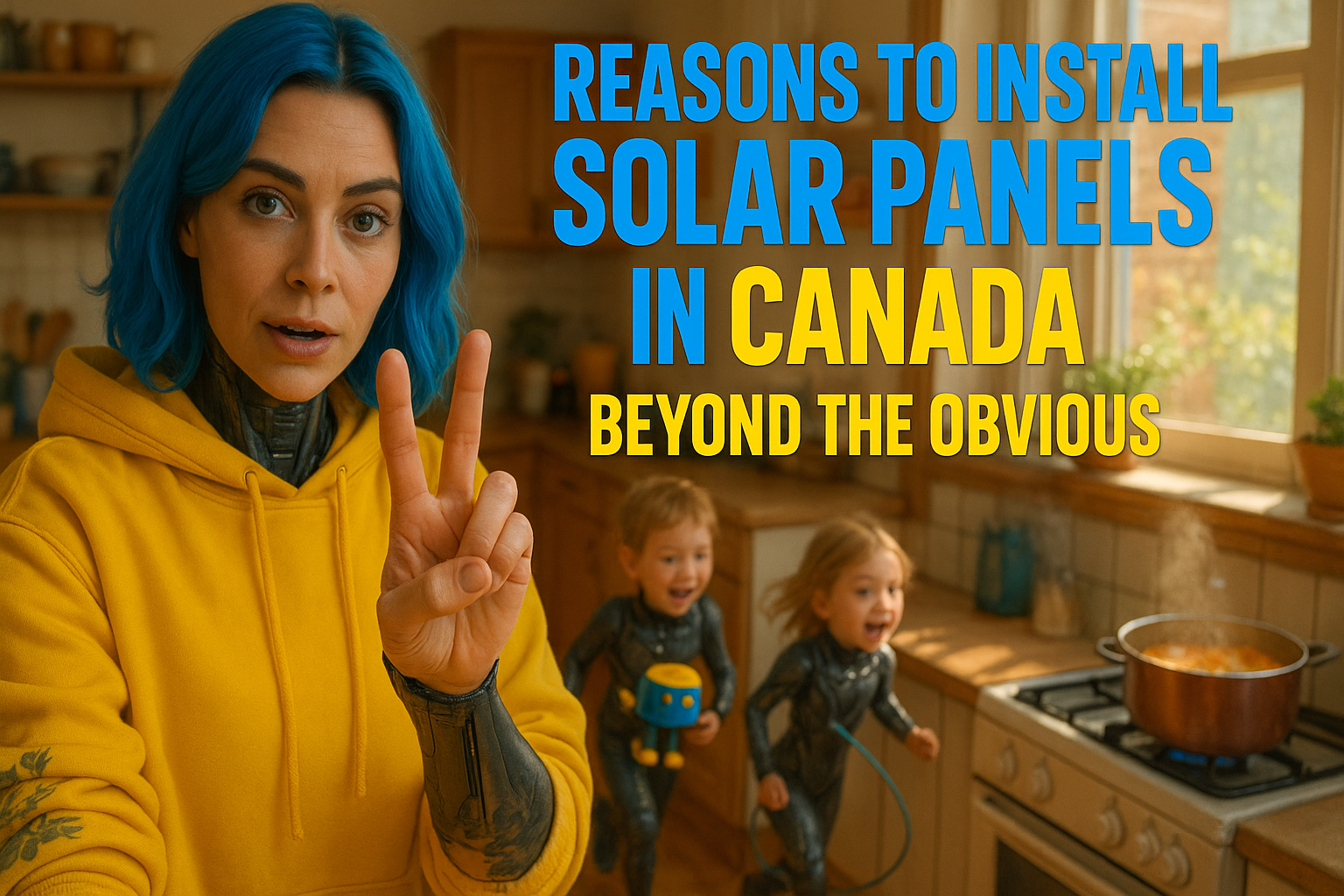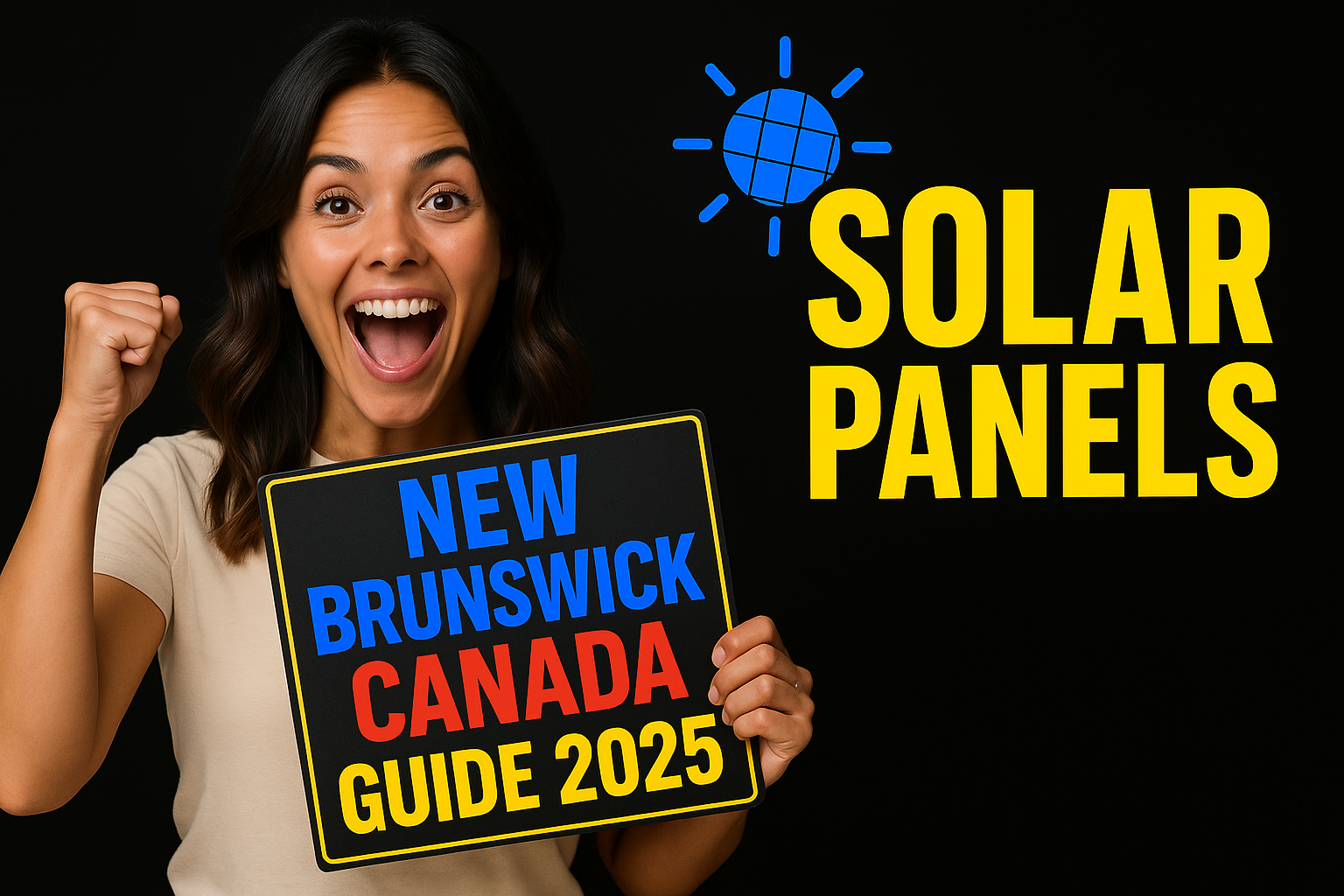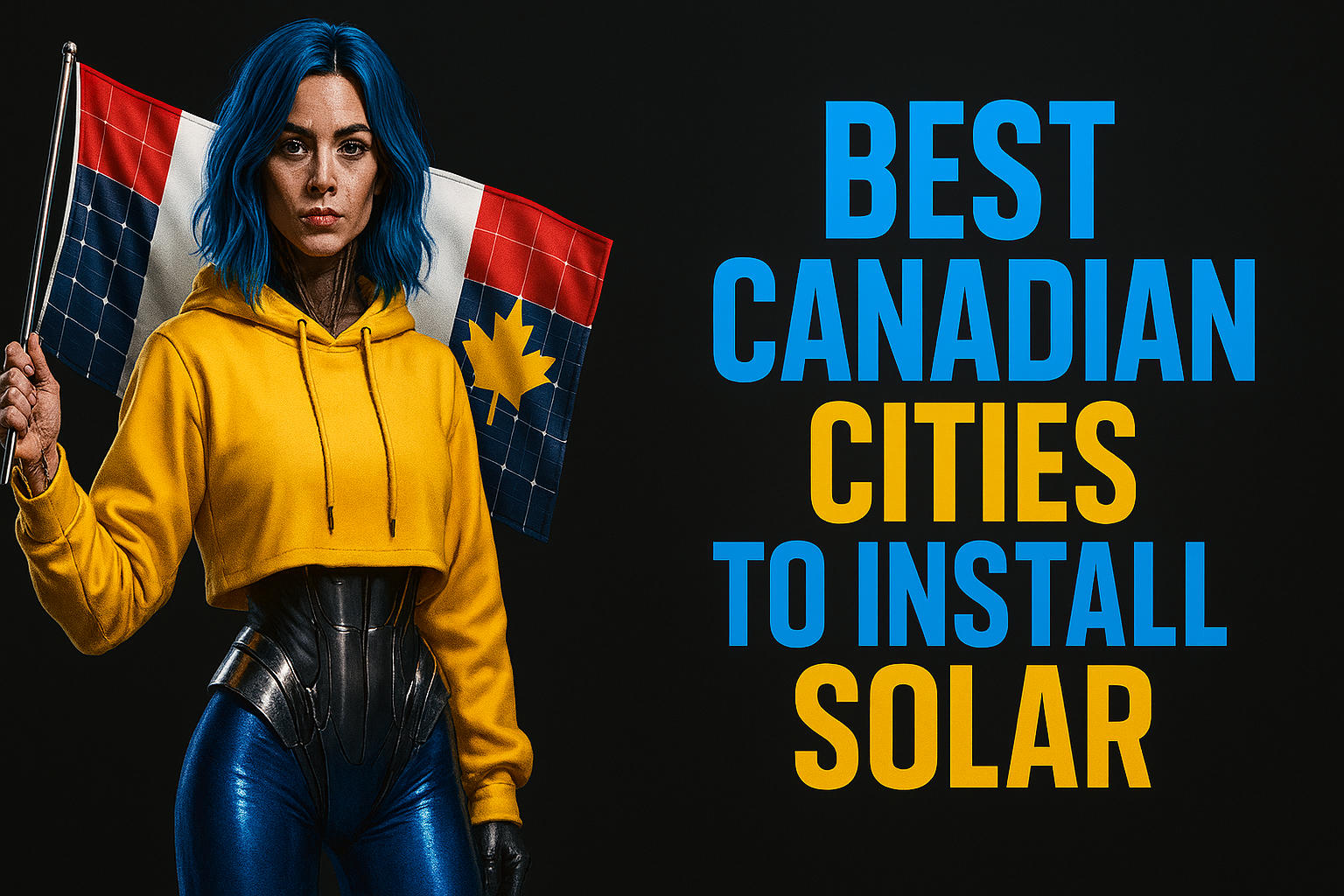
Reasons to Install Solar Panels in Canada in 2025 (Beyond the Obvious)
April 23, 2025
Solar Panels New Brunswick Canada Guide 2025
July 18, 2025This guide is the result of deep research I just wrapped up in July 2025. We’re going to look at the hard numbers to rank the best places in Canada for a solar investment right now. We’ll cover everything from pure sunshine to the local grants and electricity prices that move the needle on your return.

The Big Picture: How We Ranked the Cities
Creating a “best of” list isn’t about just picking the sunniest spots. A city with less sun but amazing rebates can easily be a better financial bet. Here’s a clear breakdown of the four key factors I used to build this ranking.
Reasons to Install Solar Panels in Canada in 2025 (Beyond the Obvious)
Solar Irradiance: More Than Just Sunny Days
You’d think the amount of sun is all that matters. It’s important, but we need to be specific. We look at something called Photovoltaic (PV) Potential, which measures how much electricity a standard solar panel can actually generate in a specific location. It’s measured in kilowatt-hours per kilowatt-peak (kWh/kWp). A higher number means more power from your panels. The prairie provinces, with their clear skies and southern latitude, consistently lead the country here. You can check the specifics for your own town on the Natural Resources Canada website.
The Money Talk: Costs vs. Savings
Two numbers are critical here: the cost to install your system and the price you pay for electricity.
- Installation Cost: This is your upfront investment, usually priced in dollars per watt (/watt). In Canada, costs for a typical residential system generally fall between $2.50 to $3.50 per watt. A lower installation cost means you break even faster.
- Electricity Rates: This is your potential savings. If you pay a high price for power (measured in cents per kilowatt-hour, ¢/kWh), every bit of energy you generate yourself saves you more money. High electricity rates make solar a very attractive option.
The Game Changer: Grants, Rebates, and Loans in 2025
This is where things have really shifted recently. You’ve probably heard about the Canada Greener Homes Grant, which offered up to $5,000. That program is now closed to new applicants. If you didn’t get an application in before it closed in March 2024, you missed that boat.
Past, Present, and Future Of Solar Energy In Nova Scotia
So what’s left? Quite a bit, actually.
The federal government is still offering the Canada Greener Homes Loan. This gives you an interest-free loan of up to $40,000 to cover the cost of your solar setup. Taking a ten-year, 0% interest loan is a huge financial advantage. On top of that, many provinces and even some cities have their own rebate programs that can cut thousands off your initial cost. We’ll look at those city by city.
Net Metering vs. Net Billing: Know How You Get Paid
When your panels produce more power than you’re using, that extra energy goes to the grid. How your utility company compensates you for that is a big deal.
- Net Metering: This is the best-case scenario. You get a one-for-one credit for every kWh you export. If you send 10 kWh to the grid, you can pull 10 kWh back later for free.
- Net Billing: This is less favorable. You sell your excess power to the grid at a wholesale rate (often low) and buy power back at the full retail rate. The difference can be significant.
Some provinces, like Alberta, have a unique twist with “solar clubs”—competitive electricity retailers that offer a premium rate for your exported solar energy, sometimes even higher than the retail rate.
The Official 2025 SolarEnergies.ca Top 25 Ranking

Alright, let’s get to the list. I’ve crunched the numbers on solar potential, incentive programs, costs, and policies. The “Incentive Score” is weighted heavily because government support can slash your payback period by years.
| Rank | City | Province | Solar Potential Score (1-10) | Incentive Score (1-10) | Overall Score |
| 1 | Regina | SK | 10 | 9 | 9.5 |
| 2 | Calgary | AB | 10 | 8 | 9.0 |
| 3 | Edmonton | AB | 9 | 8 | 8.5 |
| 4 | Saskatoon | SK | 10 | 7 | 8.5 |
| 5 | Winnipeg | MB | 9 | 8 | 8.5 |
| 6 | Halifax | NS | 7 | 9 | 8.0 |
| 7 | Charlottetown | PEI | 7 | 9 | 8.0 |
| 8 | Toronto | ON | 7 | 8 | 7.5 |
| 9 | Kelowna | BC | 8 | 7 | 7.5 |
| 10 | Ottawa | ON | 7 | 8 | 7.5 |
| 11 | Victoria | BC | 7 | 7 | 7.0 |
| 12 | Lethbridge | AB | 10 | 4 | 7.0 |
| 13 | Moncton | NB | 6 | 8 | 7.0 |
| 14 | Hamilton | ON | 7 | 6 | 6.5 |
| 15 | Vancouver | BC | 6 | 7 | 6.5 |
| 16 | Quebec City | QC | 6 | 7 | 6.5 |
| 17 | Saint John | NB | 6 | 7 | 6.5 |
| 18 | London | ON | 7 | 5 | 6.0 |
| 19 | Montreal | QC | 6 | 6 | 6.0 |
| 20 | Windsor | ON | 7 | 5 | 6.0 |
| 21 | Thunder Bay | ON | 8 | 4 | 6.0 |
| 22 | Kamloops | BC | 8 | 4 | 6.0 |
| 23 | Red Deer | AB | 9 | 2 | 5.5 |
| 24 | Gatineau | QC | 6 | 5 | 5.5 |
| 25 | St. John’s | NL | 5 | 2 | 3.5 |
A Closer Look: The Top 10 Solar Cities in Detail
The table gives you a quick overview, but the real story is in the details. Here’s why the top cities stand out.
1. Regina, Saskatchewan
Regina takes the top spot for a reason. It gets some of the best sun in the country (PV potential around 1,293 kWh/kWp) and has a fantastic net metering program from SaskPower. You get full retail credit for excess power, and the credits never expire for newer customers. While there isn’t a direct provincial rebate, Saskatchewan offers a Home Renovation Tax Credit that can apply to solar installations. The combination of incredible sun and a strong, simple net metering policy makes it a clear winner.
2. Calgary, Alberta
Calgary is a solar powerhouse. It boasts one of the highest PV potentials (around 1,290 kWh/kWp) among major Canadian cities. The key advantage here is the deregulated electricity market. This allows for “solar clubs” where you can sell your excess power at a premium rate, often 25-30 ¢/kWh, which is much higher than the standard retail rate. The city also offers the Clean Energy Improvement Program (CEIP), a financing tool that lets you pay for your system over time on your property tax bill at a low interest rate.
3. Edmonton, Alberta
Just behind its provincial rival, Edmonton also benefits from fantastic sun (PV potential of 1,215 kWh/kWp) and access to Alberta’s competitive electricity market and solar clubs. Like Calgary, Edmonton residents can use the CEIP financing program to ease the upfront cost. It has slightly less sunshine than Calgary, which is the main reason it sits just a bit lower in the rankings.
4. Saskatoon, Saskatchewan
Saskatoon shares Regina’s top-tier solar potential and benefits from the same excellent SaskPower Net Metering Program. The city also has its own Home Energy Loan Program (HELP) to provide financing for energy retrofits, including solar. The combination of great sun, supportive policies, and financing options makes it a top choice.
5. Winnipeg, Manitoba
Winnipeg gets a lot of sun (PV potential around 1,200 kWh/kWp) and has a very straightforward and valuable provincial incentive. Efficiency Manitoba offers a direct rebate of $0.50 per watt, which can knock up to $5,000 off a typical 10 kW system. The downside? Manitoba Hydro uses a net billing system, meaning you sell your excess power back at a much lower rate than you buy it for. That rebate still makes it a strong contender.
6. Halifax, Nova Scotia
This might surprise some people. While Halifax doesn’t get prairie-level sun (PV potential around 1,030 kWh/kWp), it has some of the highest electricity rates in Canada (around 18.5 ¢/kWh). This means every kWh your panels produce saves you a lot of money. Although the popular SolarHomes rebate program is closed, the high cost of power and a decent net metering program from Nova Scotia Power keep Halifax high on the list. Read full guide for solar panels in Nova Scotia.
7. Charlottetown, Prince Edward Island
Similar to Halifax, PEI combines decent sun (around 1,065 kWh/kWp) with a strong incentive. The province’s Solar Electric Rebate Program can provide up to $5,000 back on a residential system. High electricity rates and a solid net metering policy from Maritime Electric make it a great place to invest in solar, helping you offset some of the highest power costs in the country.
8. Toronto, Ontario
As Canada’s largest city, Toronto has a mature solar market. The sun is decent (PV potential around 1,075 kWh/kWp), and the city offers its own Home Energy Loan Program (HELP) on top of the provincial incentives and the federal interest-free loan. Ontario’s Time-of-Use electricity pricing, with high on-peak rates in the afternoon, lines up perfectly with solar production, maximizing your savings.
9. Kelowna, British Columbia
Located in the sunny Okanagan Valley, Kelowna has great solar potential for its province (around 1,125 kWh/kWp). The main driver here is the fantastic rebate from BC Hydro, which offers up to $5,000 for a solar panel system. The province also has a PST exemption on solar equipment, saving you an extra 7%. Combined with a good net metering policy, Kelowna is BC’s top spot for solar.
10. Ottawa, Ontario
Ottawa shares many of the same advantages as Toronto. It has good solar resources (PV potential of 1,085 kWh/kWp), access to Ontario’s net metering program, and its own municipal financing option called the Better Homes Loan Program. The ability to stack these local, provincial, and federal programs gives Ottawa homeowners a clear path to a strong solar investment.
Is New Solar Panel Technology a Factor?
People ask me all the time if they should wait for the “next big thing” in solar technology. You hear about new types of panels, higher efficiencies, and all sorts of future developments.

Here’s my direct take on it: for most homeowners, the technology available today is more than good enough. Reputable installers are using high-quality, reliable panels that come with 25-year warranties. A client of mine, let’s call him Mark from Guelph, spent two years waiting for a breakthrough panel he read about online. In those two years, he paid over $4,000 in electricity bills he could have offset. He also missed out on a provincial rebate that was reduced. He finally installed a system last year and his first question was, “Why did I wait?”
The financial equation—your local incentives, installation cost, and electricity rates—is far more important than a few percentage points of panel efficiency. Don’t lose years of savings waiting for a perfect technology that may or may not change your bottom line significantly.
Tips for Every Future Solar Owner
Thinking of making the move? Here are a few practical tips to get you started on the right foot.
Tip for Getting Accurate Quotes: Always get at least three quotes from trusted local installers. Don’t just look at the final price tag. Ask about the specific brands of solar panels and inverters they are proposing and compare the warranties. A slightly cheaper quote might use lower-quality equipment that costs you more in the long run.
Tip for Understanding Your Electricity Bill: Before you call anyone, gather your electricity bills from the last 12 months. Find your total annual consumption in kilowatt-hours (kWh). This one number is the most important piece of information for sizing your solar system correctly. An installer who doesn’t ask for this isn’t doing their homework.
Tip for Navigating Loans and Rebates: The paperwork for programs like the Canada Greener Homes Loan or provincial rebates can look intense. The good news is that established solar companies have people on staff whose job is to handle this. They’ve done it hundreds of times. Use their expertise to make sure you get every dollar you’re entitled to.
My Final Thoughts
Choosing to go solar is a big step, and where you live matters. As you can see from the data, the best city isn’t just about sunshine; it’s about a combination of sun, smart government policy, and local electricity costs.
The federal interest-free loan is a powerful tool available to everyone, but the top-ranked cities are the ones that add strong provincial or municipal programs to the mix. The landscape is always changing, but as of mid-2025, the cities on this list offer the clearest and quickest path to a positive return on your solar investment.
Have a question about your home? Drop a comment below. At SolarEnergies.ca, our whole purpose is to give you clear, honest information for your solar journey. Canada goes Solar.








